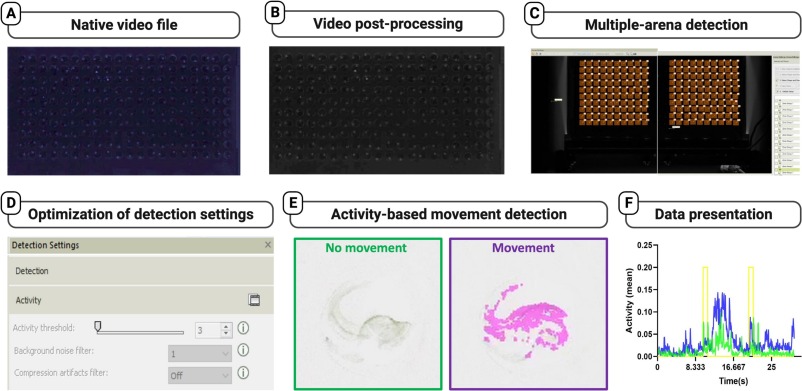Fig. 1 High-throughput bioinformatic protocol developed specifically for high-throughput PMR bioassays, enabling efficient analysis and screening of chemicals for their effects on zebrafish neurobehavior. The figure illustrates the step-by-step workflow involved in the bioinformatic analysis of PMR bioassays to enable high-throughput screening of neurotoxic and neuro-modulating chemicals. A) Ingestion of native video files: The process begins with the ingestion of the native video files into video editing software. These files contain recorded PMR responses of zebrafish embryos. B) Post-processing of video files: The native video files undergo post-processing steps, including conversion from color to grayscale to enhance visibility of PMR responses. Digital de-noising and sharpening techniques are applied to improve the quality and clarity of the video files. C) Ingestion into custom Ethovision XT templates: The processed video files are then ingested into custom Ethovision XT templates. Each template consists of 100 arenas, allowing for the analysis of 200 individual embryos on a single embryo array. Each video file needs to be tracked twice to complete the analysis of all embryos. D) Optimization of activity threshold: An activity threshold is optimized to ensure consistent and accurate tracking detection across the entire embryo array. This step helps in distinguishing and capturing relevant pixel intensity changes associated with PMR responses. E) Activity-based animal detection: The bioinformatic analysis involves activity-based animal detection, which tracks the pixel intensity changes in subsequent frames of the video files. This detection method allows for the identification and tracking of zebrafish embryos exhibiting PMR responses. F) Data analysis and graphical presentation: The final step includes data analysis and graphical presentation of the PMR responses. Various parameters and metrics are calculated, and the results are presented graphically to provide insights into the effects of neurotoxic and neuro-modulating chemicals on the zebrafish embryos' behavior.
Image
Figure Caption
Acknowledgments
This image is the copyrighted work of the attributed author or publisher, and
ZFIN has permission only to display this image to its users.
Additional permissions should be obtained from the applicable author or publisher of the image.
Full text @ Comp. Biochem. Physiol. C Toxicol. Pharmacol.

